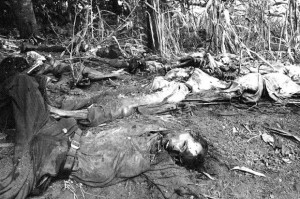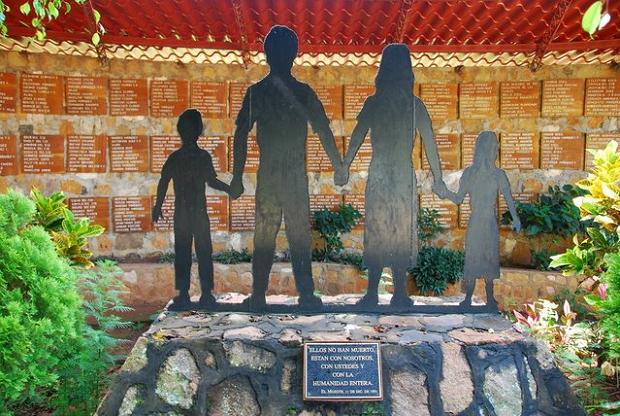El Salvador: 30 Years after El Mozote Politics
Ideas, New in Ceasefire - Posted on Thursday, December 15, 2011 5:31 - 2 Comments
The memorial at El Mozote lists the names of all who were killed in the massacre
To mark the 30th anniversary of the atrocious El Mozote massacre of 10 Dec 1981 – at the onset of a bloody civil war (1980-1992) which resulted in the deaths of more than 70,000 people in total –, a ceremonywas held in El Mazote on Saturday, attended by El Salvador’s Foreign Minister, Hugo Martínez.
Martínez said the event sought to ‘honour the memory of hundreds of innocent people who were murdered 30 years ago here in El Mozote and in nearby towns’, with the statesman also asking forgiveness for what he called the ‘blindness of state violence’ .
Between 10-11 December 1981, members of the US-trained Atlacatl, an anti-guerilla elite battalion headed an incursion into El Mozote following suspicions of collaboration between the villagers and anti-government rebel forces.
According to a report by Archdiocesan human rights group Tutela Legal, an estimated 393 people were brutally tortured, raped and killed, including men, women and mostly children (their bodies and houses burned after the killings), although the total death toll is placed at 794 when including military operations in nearby towns which took place between 10-13 December. A 1992 report by Human Rights Watch describes El Mozote as “probably the largest mass killing reported during the war” (p. 3).
The United States’ involvement in the civil conflict and specifically in the El Mozote massacre grants a certain amount of legitimacy to Simón Bolívar’s assertion that the “United States [seems] destined to plague and torment the continent in the name of freedom” (1829).
For, much like in Honduras, Nicaragua and Guatemala, both the Carter and Reagan administrations offered training as well as extensive funding and armament to security forces in fear of losing the government to what was described – along Kessingerian lines – as the spread of the virus of ‘communist terrorism’.
In truth, the real fear – and for good reason – amounted to the possibility of the spread of a virus, indeed, but that of establishing a democracy in El Salvador – much like in Chile under Salvador Allende – that would further the welfare of the majority of its own people, instead of privileging corporate and foreign interests. This ‘rotten apple’ might give other countries in the region and elsewhere the wrong kind of ideas.
Lieutenant Colonel Domingo Monterrosa was the founding commander of the Atlacatl Batallion (1980), after serving in the army for several years and completing a course at the US Army’s infamous (and still operational) School of Americas (SOA) in 1966, at a time when the school was located in Panamá.
The US-trained SOA graduate later confessed to having organised and participated in the El Mozote massacre during an interview with reporter James LeMoyne in which he is heard saying: “Yeah, we did it. We killed everyone. In those days I thought that was what we had to do to win the war. I was wrong”.
In his Turning The Tide (p. 122), Noam Chomsky highlights that in March 1984 “it was revealed publicly that US planes were rapidly increasing reconnaissance to provide intelligence for what the government and the press call “military operations””, which included “ground sweeps and massacres [of civilians] by US-trained elite units”.
 According to a forensic investigation into El Mozote conducted after the 1992 peace accords, “the cases were all fired in a 5.56 mm NATO-caliber firearm” and “appear to have been fired in United States M-16 military rifles”.
According to a forensic investigation into El Mozote conducted after the 1992 peace accords, “the cases were all fired in a 5.56 mm NATO-caliber firearm” and “appear to have been fired in United States M-16 military rifles”.
Furthermore, there is compelling evidence pointing to the undisclosed presence of US officials in El Mozote during the massacre (it is widely known that there were at least US military advisers operating in El Salvador at the time), as journalist Mark Danner suggests in a 1993 article for the New Yorker:
“a number of highly placed Salvadorans, including one prominent politician of the time who had many friends among senior officers, claim that two American advisers were actually observing the operation from the base camp at Osicala. On its face, the charge is not entirely implausible — American advisers had been known to violate the prohibition against accompanying their charges into the field — but it is impossible to confirm.”
The US officially praised the efficiency of the Atlacatl Batallion on several occasions. During a Senate hearing on El Salvador which took place on 8 February 1992, Assistant Secretary of State for Human Rights Elliott Abrams stated that ‘the battalion to which you refer [Atlacatl] has been complimented at various times in the past over its professionalism and over the command structure and the close control in which the troops are held when they go into battle’.
The perpetrators of the El Mozote and other equally vicious massacres – along with their supporters in the Carter and Reagan administrations (including the Presidents themselves) – were never charged, as authorities granted all forces a general pardon following the peace accords of 1992 which put an end to the war.
This week’s commemorations, nonetheless, serve as a stark and necessary reminder of the devastating impact US foreign policy has had on the region over the past few decades. It remains to be seen whether US involvement in El Salvador’s civil war would ever be brought to justice, but if the region’s move away from American influence over the past few years is any guide, the verdict of history has already been delivered.
2 Comments
Bo Modén
Kathryn Vogelsang
This is so horrible it makes one ashamed to be an American



During my years as the first representative for Swedish Save The Children in Central America 1982-1985 I was forced to se, to know and to understand “The US terror in the region”. The brutal war against the peoples of the region, the church, the Jesuits….all was supervised by Ambassador John Negroponte in Honduras. (AKA Nekroponte). The planning from the group behind PNAC (Project for a New American Century) released “The Salvadorean Option” in Irak with expert assistance from John Negroponte. Esquadrones de la muerte is now spreading from “The School of Americas” to all parts of the world. We have to watch closely the new regime in Guatemala. There we may se a new wave of killings in the country a BBC film named “Killers Paradise”.